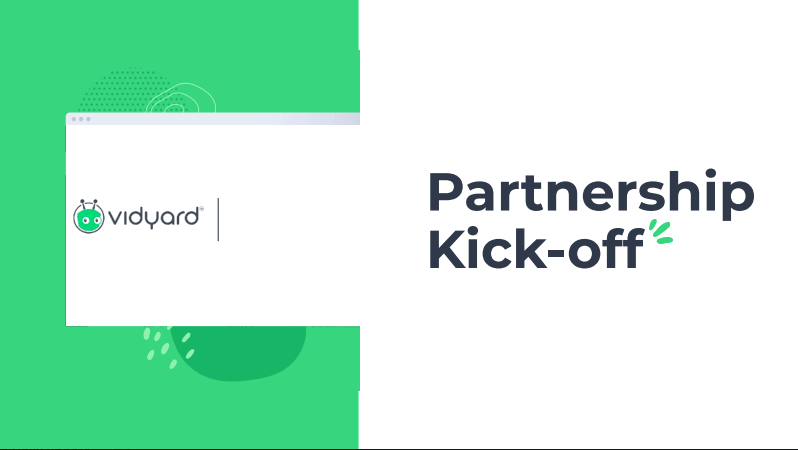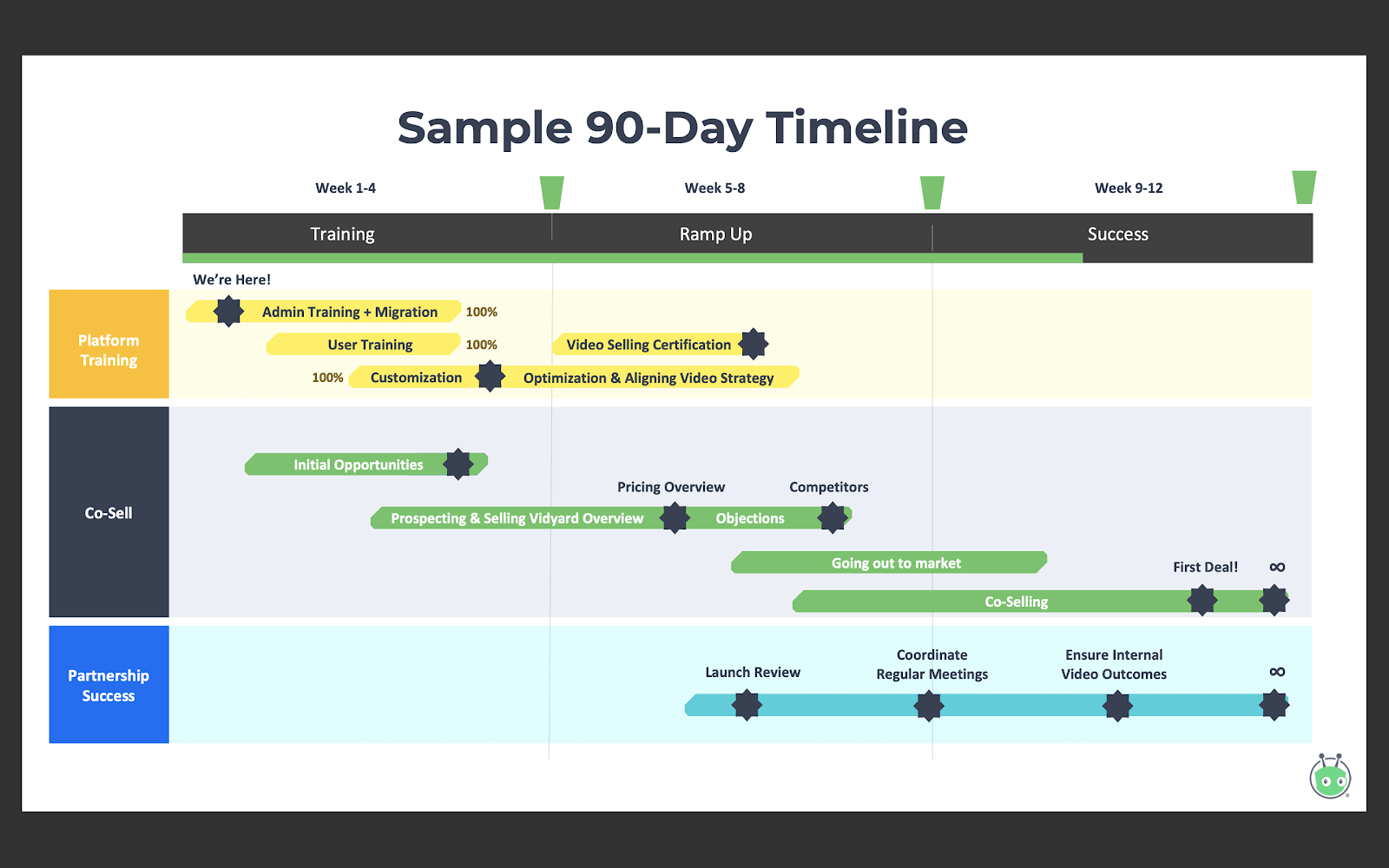The inner workings of Vidyard’s four-phased enablement program, plus tactics and templates that you can apply to your own partner program.

If the phrase “Mo’ Partners, Mo’ Problems” feels all too real, it could be a sign that your partner program is experiencing some growing pains.

When Vidyard’s partnerships team felt those pains in June 2020, they hired Will Taylor, their first-ever partner enablement manager, to help their 115+ agency partners realize value faster and increase their partner retention rate. To achieve this, Taylor and the Vidyard team launched a four-phased enablement program to streamline agency partners’ adoption and implementation of Vidyard’s online video platform, and help partners develop complementary services.
Now, six months later:
- Agency partner retention increased 70%
- The number of agency partners increased 75%
- The partnerships team doubled in size
- Partners are ready to sell services in 60 days
- Agency program revenue doubled
In this post, you’ll get an inside look into Vidyard’s four-phased enablement program and gain insights that you can apply to your own enablement efforts.
A Four-Phased Approach to Enabling Partners
The approximately 90-day enablement program begins when an agency signs a formal partnership agreement with Vidyard. The program has four phases: discovery; platform setup, rollout, and user training; analysis and evaluation; and service development.

Phase 1: Discovery
The discovery phase begins with a kick-off meeting that includes:
- the assigned partner enablement manager
- the assigned channel account manager from Vidyard
- the agency’s team members.
The meeting’s objective is for both teams to set goals and align expectations about Vidyard’s responsibilities vs. the partner’s responsibilities.
Taylor uses a kick-off slide deck (see template below) that covers:
- A business overview of the agency, including its competencies and primary drivers for partnering with Vidyard
- Introductions to stakeholders from the agency’s team and an overview of the key roles (e.g. executive, marketing, sales, service, design/web) who will use Vidyard
- A deeper dive into the product, partnership, and business goals related to the agency’s use case of Vidyard, plus primary outcomes, metrics of success, and potential challenges for each goal
- Expectations about the individual and shared responsibilities from Vidyard and the agency


During this kick-off meeting, it’s critical to set clear expectations. The Vidyard team will assign tasks, set goals, define milestones, and discuss the partner’s responsibilities and tasks. Both teams can see these items in the partnership kick-off deck.


Taylor says, “If we give information and don’t ask for anything in return or set a task, then in their minds they’re going to think, ‘I just learn, I don’t have to do.’”
He adds, “The ‘doing’ part and setting the expectation of ‘doing’ is critical because these are people running their own business, and getting them to prioritize this in their mind is extremely important.”
Phase 2: Platform Setup, Rollout, and User Training
During the following 60 days, the partner enablement manager coordinates and leads two or three one-hour Zoom sessions to train specific agency team members (including their assigned platform administrator and others who will be using Vidyard on behalf of clients). The goal is to help the partner understand how Vidyard works so they can use it on their own and with clients.
Live sessions offer a quicker feedback loop than a pre-recorded video or a written guide. By making the sessions interactive and answering partner’s questions on the fly, Taylor can quickly gauge which concepts are clicking and which ones require more explanation or training.
He’ll also check product usage data to see where an agency partner needs more exposure, and then hone in on those topics or schedule additional sessions.
“We’re making sure that they have the technical competence to use the platform for themselves because that will translate to being their own best use case,” he says. “It’s not just ‘Here’s where you click,’ it’s ‘Here’s how you do this and here’s the value of why you would do that or why a client would do that.’”
While the training sessions’ focus is mostly technical, Taylor also touches on how the partner could use Vidyard to solve clients’ use cases. This helps the partner think about where Vidyard might fit within their existing services and can potentially plant seeds for new service offerings (more on services later).
“This opens up an opportunity for us to have a conversation around, ‘Okay, what’s your expertise as our partner? You focus on these key areas. Well, in the platform, we just went through this in our training. You could build a service around that.’”
Phase 3: Analysis and Evaluation
Taylor and the partner will then hold one or two 30-minute sessions to evaluate the partner’s platform adoption and check progress toward their goals.
The meetings usually take place in the month after the technical onboarding. “Agencies would get busy,” he says. “So this is an appropriate time to get them to actually use it in real scenarios to find any bumps and work out the kinks.”
To prepare for these sessions, Taylor reviews the partner’s activity in the platform and assesses their overall adoption. From there, he crafts recommendations to help the partner achieve the goals they established during the kickoff meeting.
Taylor says the conversation usually goes like this, “Based on how things are going, do you think you’ll hit X goal? When do you think you’ll be comfortable with positioning Y? I recommend you take these actions…”
These check-ins give the partner a chance to ask questions, learn about certifications (more on that later), and share ideas for webinars or other co-marketing campaigns. They can also surface challenges or opportunities. Perhaps they need to lean into more technical training, or maybe they need support from Vidyard’s partner team on a sales opportunity that’s gaining traction.
By the time phase three kicks off, Taylor finds that most partners are eager and excited to move as quickly as possible with their go-to-market plans. He even recalls one partner saying mid-training, “Let’s cover this piece of the platform another time. I want to know how to get certified. We’re already developing a page for these services, and I want to dive into that and get guidance.”
Phase 4: Service Development
For the partners who are curious about certifications, Taylor will give them an overview of Vidyard’s two certification programs (the Video Selling Certification and the Implementation Certification) so they can understand what to expect, and how it will help deepen their platform expertise.

The Video Selling Certification — which takes place via guided calls — prepares partners to develop sales and marketing consulting and/or coaching services for clients wanting to use video.
The hands-on certification process teaches partners how to identify opportunities, how to prospect and sell Vidyard, how to handle objections, and how to go to market.
“We’re asking them more questions because we need to learn more about their business process,” says Taylor. “They have to think about their business strategy and do a bit more work on their end, and they’re already busy enough.”
Taylor works with the partner to brainstorm ideas for new services, and he arms the partner with helpful resources like video scripts and email templates to teach them how to apply video to inbound and outbound sales.

“The ideal state is for every interaction that they’re having, they’re talking about Vidyard because it’s a part of their services,” says Taylor. “They will benefit from the service revenue that results from that, which will make them be more successful in the overall program.
Here are some examples of services that an agency partner might create:
- Sales enablement with video – Helping its clients use video during their sales process to engage prospects and buyers
- Video marketing – Helping its clients incorporate video into their email marketing cadences to strengthen their demand generation initiatives
- Recruiting – Helping its clients use video to source candidates and build rapport with them through personalized video
When a partner completes the Video Selling Certification, they can proudly show off their official badge and brand their expertise (just like digital agency Lake One® does here).

And the process outlined above is working. Before, Vidyard had 10 certified agency partners, but now they have 30.
What Happens Next: Measuring a Return on Enablement
When a partner has earned its certification wings by completing the steps above, it’s ready to leave the enablement nest. Vidyard’s channel account manager and the partner get to work, exploring new co-marketing or co-selling opportunities with clients.
However, the partner enablement manager will still have ongoing contact with the account team and the partner to check on progress and measure it against their established goals. This also gives the partner enablement team a feedback loop: After the 90-day enablement program, is the partner successful? If not, where are there gaps? What areas or topics should Vidyard’s team double down on with other partners?
Quarterly Business Reviews
Taylor and the channel account manager will meet quarterly with select agencies who are heavily engaged in the partner program. These check-ins help the Vidyard team evaluate the partner’s progress and see if they need more platform or service development training.
“We’re essentially looking to identify more ways for [partners] to see value from the program as a whole,” he says.
“Give us a breakdown of the services you delivered and let’s tie it back to Vidyard and how we did it so we can a) recreate it for you and apply those learnings to other partners and b) so you can continue to lean into that and drive more revenue.”
To prepare for and manage these discussions, Taylor uses the DARCI framework, a project management model that clearly outlines tasks based on stakeholder’s roles. (DARCI stands for Decision-Maker, Accountable, Responsible, Consulted, and Informed.)
Vidyard is responsible for bringing reports on closed-won business with the partner to understand the factors influencing those wins and identify patterns to recreate future wins. The partner is responsible for bringing reports on service revenue tied to won opportunities.
He uses a shared Vidyard Partnership Workbook (see template here) to guide his meetings and ensure there’s no confusion about expectations and next steps.
Here’s what the workbook includes:
Tab 1: Regular meetings: This includes line items for short-term tasks, owners, dates, and potential challenges. Taylor uses this tab to guide his check-ins and keep track of each person’s responsibilities.

Tab 2: The partner’s strategic plan: The top half of the sheet is an overview of the partner’s company (i.e. mission statement, customers, employees). The bottom half includes the partner’s high-level goals, targets, next steps, and a list of stakeholders based on the DARCI framework.

Tab 3: A description of the workbook – It includes Vidyard’s partner team’s mission statement, a breakdown of how the DARCI model works, and an overview of how to use the workbook.

Enablement Metrics: Partner Retention & Agency Program Revenue
Taylor’s “north star” metric is partner retention rate.
So, how does Vidyard keep track of retention? When a partner joins Vidyard’s agency partner program, they pay a fee and sign an annual partnership agreement, getting access to the full suite of Vidyard’s software. When it comes time for the renewal, the partner just needs to crunch a few numbers to understand their ROI.
“The success of our program is essentially predicated on how many dollars the partners make themselves from their own services,” says Taylor.
Here’s a hypothetical example:
Let’s say an agency pays $10 to join the partner program, and after a year, they generate $100 in revenue by selling complementary services. That’s a 10x return on their partnership investment — a clear indicator that they should renew their partnership agreement with Vidyard.
Taylor is also tracked on a portion of overall partner program revenue because of his role in getting partners up and running, shepherding them through the certification process, and setting them up to successfully deliver services to clients.
–
“I see enablement as something that really makes your partners feel like partners. They actually feel like they are supported like anyone else in your business so that they feel like an extension of your business.”
When you make your partner feel like partners, it certainly pays off.






































































































